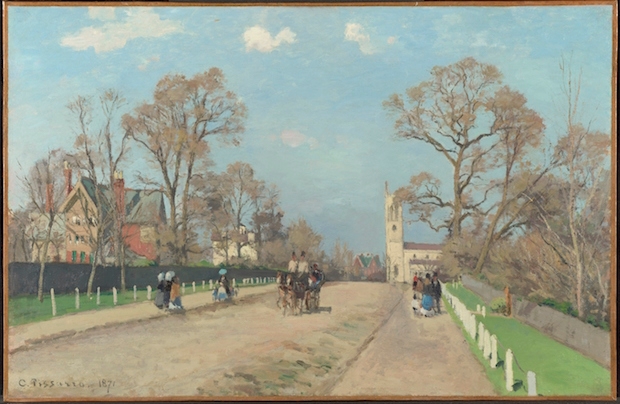When it was suggested that a huge exhibition of Impressionist paintings should be held in London, Claude Monet had his doubts. Staging such an exhibition, he wrote to his dealer Paul Durand-Ruel, would be ‘unwise’ and only likely to baffle a London public that ‘knows very little about us’. That was in 1904. What, one wonders, would Monet make of Inventing Impressionism, which has just opened at the National Gallery 111 years later?
It can hardly be said now that the British know little of the Impressionists. On the contrary, you could argue we’ve seen quite enough of them in recent decades. The challenge for a gallery planning to put on such an exhibition is how to make it different. That is, how to make it more than just a lot more assorted Monets, Renoirs and whatnot?
Does Inventing Impressionism clear that bar? It certainly has a novel point of departure. The subtitle explains the subject: ‘Paul Durand-Ruel and the Modern Art Market’. This, then, is not so much about Monet and co., as about his dealer, the man to whom that slightly querulous letter was sent (and who subsequently ignored its advice).
The late critic David Sylvester used to claim that, to get the art game started, five players were required: the artist, the collector, the museum curator, the writer and the dealer. Exhibitions can — and have —been built around the activities of all five, although those concerned with the prime producers — artists — are naturally by far the most common.
Paradoxically — since Durand-Ruel (1831–1922) was a staunchly conservative Catholic monarchist and anti-Dreyfusard — he was revolutionary when it came to art and art dealing. He began with a family business — a stationery shop in Paris that also dealt in pictures — and transformed it into an international operation that promoted, publicised and marketed his artists. Durand-Ruel was among the first, for example, to present solo gallery shows devoted to recent work by a single individual, which is now such a staple of the art-world calendar. He was the ancestor of such titanic contemporary galleries as Gagosian and White Cube.
The walls of Inventing Impressionism and the accompanying catalogue are full of grateful tributes from the painters to their dealer. ‘We would have died of hunger,’ exclaimed Monet, perhaps exaggerating a bit, ‘without Durand-Ruel.’

Unquestionably, he kept the Impressionists afloat through a difficult decade and more. As a result, Durand-Ruel himself came close to financial ruin on several occasions. ‘To think,’ he reflected in old age, ‘had I passed away at 60, I would have died debt-ridden and bankrupt, surrounded by a wealth of underrated treasures.’
The turning point came in 1886, when Durand-Ruel exhibited in New York. As has often happened since, acceptance in the United States made adventurous European artists rich. Germany was the other country that took enthusiastically to Impressionism. The British were largely indifferent, the French often apoplectic.
In Paris, such softly pretty works as Renoir’s nude ‘Study. Torso, sunlight effect’ (1875–6) caused consternation (one critic compared the dappled shadows on the model’s skin to ‘putrefaction in a corpse’). Perhaps the painters were accidental victims of a mood in which — after national defeat in the Franco–Prussian War and near-revolution in the Paris Commune — any unorthodoxy seemed dangerous.
Durand-Ruel was a great innovator in his field, but what he did was organisational rather than visual. Consequently, it is hard to display on the walls of a gallery. Even so, sometimes at the National Gallery you sense the great dealer at work.
In the first room there is a recreation of the grand salon of Durand-Ruel’s Parisian apartment, near the Gare Saint-Lazare. This room was crammed with works by Renoir, and entered through double doors decorated by Monet with flowers and fruit. Here is evidence not only of Durand-Ruel’s taste, but also his methods — since his dwelling was open for visits, in effect an annex to his business premises.
Half a dozen of Monet’s paintings of poplars on the banks of the river Epte (all from 1891) give a flavour of Durand-Ruel’s exhibitions of the series paintings — of Rouen Cathedral, the haystacks and the Thames — that cemented Monet’s reputation (and wealth).
Probably as a result, by 1904 Monet was past the stage at which he felt like appearing in group shows — another reason why he was dubious about Durand-Ruel’s plan for a colossal Impressionist survey in London. This was eventually held at the Grafton Galleries, Mayfair, in 1905 and contained more than 300 works (three times as many as the present exhibition). An evocation of that triumph of Durand-Ruel the impresario concludes Inventing Impressionism.
Otherwise, what is mainly on display at the National Gallery is a selection of Durand-Ruel’s stock: a fraction of the 1,000 Monets, 1,500 Renoirs and so forth that passed through his hands, together with a few by earlier painters such as Delacroix, in whom he was interested before he discovered Impressionism. On that basis, it’s enjoyable. But it’s essentially just a mixed bag of, sometimes magnificent, paintings. I can’t help feeling that the title oversells this admirable man (ironically, since he must have been a master salesman). Durand-Ruel didn’t invent Monet or Degas; they did that for themselves.






Comments